16 Best Emotional Intelligence Activities for Employees: Enhancing EQ Through Effective Exercises
Navigating the world of work requires more than technical skills and knowledge; to be successful, employees must build a strong foundation in emotional intelligence (EI).
This vital skill set that encompasses the understanding and management of your emotions and others is not inherent – a person develops EI through intentional practice and effort.
One quick way to assess your EQ and flex your muscles is through emotional intelligence activities. Engaging in these exercises not only boosts your personal development but will also boost your team's dynamics. By enhancing your emotional quotient (EQ), you invest in building a workplace that thrives on effective communication, empathy, and resilience.
In this article, we’ll learn more about emotional intelligence and explore effective exercises that can seamlessly integrate into your daily routine.
Key takeaways
- Emotional intelligence is vital for personal and professional success and can be improved through practice.
- EQ development involves self-awareness, self-management, and building strong interpersonal relationships.
- Practical EQ activities offer a means to enhance individual skills and team dynamics in various settings.
What is emotional intelligence?
Emotional intelligence (EI), also known as emotional quotient (EQ), is your ability to recognize and manage your own emotions, as well as understand and influence the feelings of others.
Coined by psychologist Daniel Goleman, EI is a crucial component for personal and professional success as it is fundamental in how you engage with colleagues, navigate complex social environments, and make decisions that lead to success.
At its core, high emotional intelligence begins with emotional awareness – identifying what triggers your emotions and understanding how they affect your behavior. By enhancing your self-awareness, you strengthen other aspects of emotional intelligence, laying the groundwork for improved outcomes in both your personal and professional lives.
Like any skill, emotional intelligence can be developed and refined through dedicated focus and consistent practice, enabling you to better manage daily challenges and enrich your interactions across all areas of life.
These are the components of emotional intelligence:
- Emotional awareness: Recognizing the emotions you are experiencing and their effects.
- Self-knowledge: Understanding your strengths and weaknesses.
- Self-regulation: The ability to control or redirect disruptive impulses and moods.
- Motivation: A passion to work for reasons that go beyond money or status.
- Empathy: Considering other people's feelings, especially when making decisions.
- Social skills: Managing relationships to move people in desired directions.
Why is emotional intelligence important in relationships?
Emotional intelligence is vital in shaping the depth and quality of your relationships, both professionally and personally. It determines how well you understand and respond to the emotions of others and how you choose to express your own feelings.
Empathy and connection
Empathy is the cornerstone of EQ, enabling you to understand and resonate with the emotions of others. Developing emotional intelligence skills is not just about listening; it's about truly hearing and validating others' experiences.
By engaging empathetically, you lay the groundwork for deeper, more meaningful connections. This mutual understanding fosters a sense of closeness and trust, which are fundamental for robust interpersonal relationships.
Expressing and communicating emotions
Effective expression and communication of your emotions are essential for healthy relationships. EQ involves articulating your feelings in a way that is thoughtful and considerate, ensuring that your words enrich rather than complicate your interactions.
It also encompasses being sensitive to the emotional cues of others, allowing you to adjust your communication style to suit different social contexts.
Trust and hope in team dynamics
In team settings, a high EQ is crucial for cultivating trust, which is essential for collaboration and collective problem-solving. Moreover, hope, a dynamic component of EQ, is instrumental in maintaining a positive and resilient team spirit.
It helps teams persevere through challenges and view setbacks as opportunities for growth and learning. By harnessing these aspects of EQ, you enhance team dynamics and drive towards success.
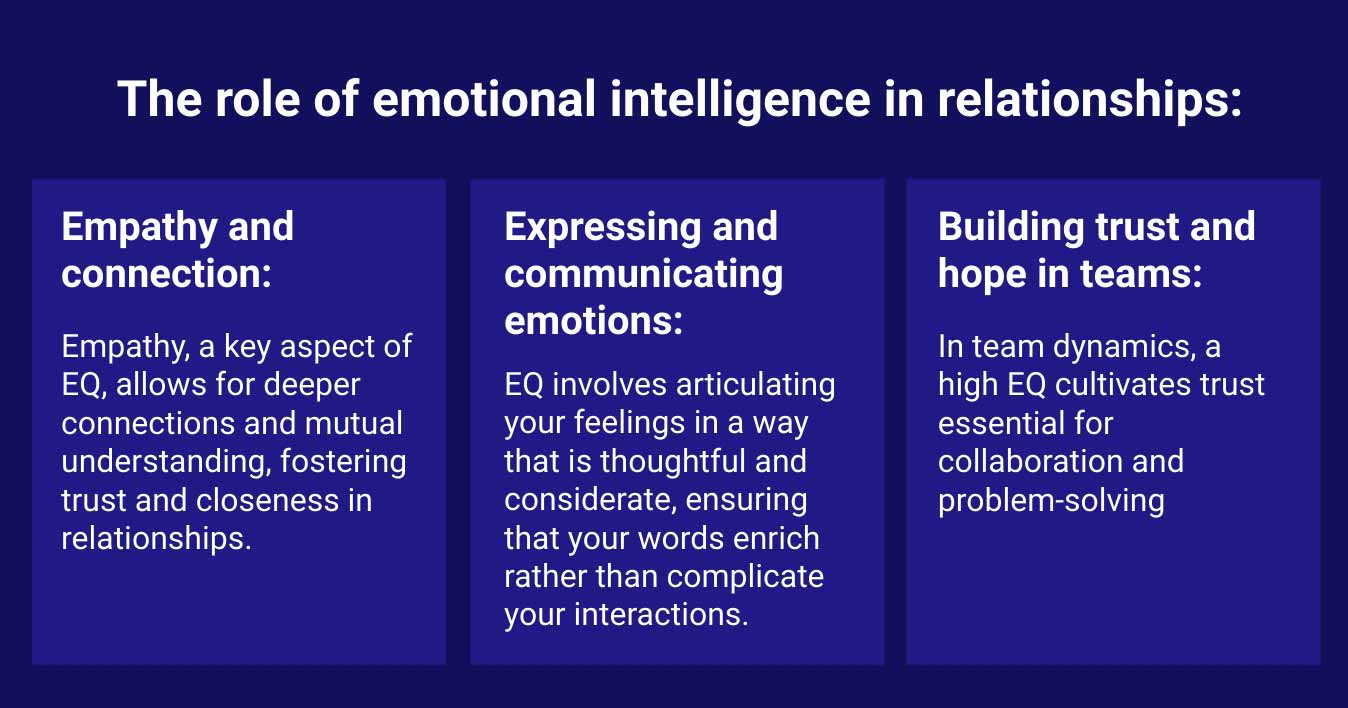
Leadership and the role of emotional intelligence
Emotional intelligence is critical for elevating your leadership capabilities, as it helps enhance interpersonal and relationship building skills, fostering stronger team connections. By honing EI, you can evolve into a mindful leader who not only commands effectively but also nurtures team unity and collaboration.
Influence and assertiveness
To lead effectively, the translation of your emotional intelligence into influential leadership must be fluid and intuitive. It hinges on a profound understanding of your team’s emotions, using this insight to motivate and guide everyone toward common goals.
A critical element of emotional intelligence in assertive leadership is self-regulation. This skill allows you to articulate your vision clearly and persuasively, avoiding aggression while steering clear of passivity. By remaining calm and confident, you effectively communicate your ideas, motivating your team to embrace and follow your lead.
Think of influence as a lever in the mechanics of leadership, with emotional awareness serving as the fulcrum and assertive communication acting as the force that moves your team’s beliefs and actions.
For example, demonstrating empathy when a team member encounters difficulties not only addresses the immediate issue but also reinforces your standing as a caring leader, thereby strengthening your influence and fostering deeper trust within your team.
Creating group cohesion
As a facilitator, your use of emotional intelligence activities is crucial in developing deeper connections among team members, thereby strengthening group cohesion. By employing skills such as active listening and empathy, you are well-prepared to accurately comprehend and address the range of emotions within your team.
Consider introducing group activities aimed at enhancing emotional intelligence, such as collaborative brainstorming sessions or team-building exercises. These activities not only foster better communication but also help build a collective sense of unity.
Your proficiency in reading emotional cues allows you to effectively foresee and resolve conflicts, ensuring that your team remains unified and in sync with organizational objectives. Plus, your ability to manage your own emotions has a positive impact on team dynamics, creating a cooperative atmosphere that respects and incorporates diverse viewpoints.
How does emotional intelligence impact company culture?
In an organizational context, your team’s emotional intelligence skills are pivotal in enhancing workplace dynamics and outcomes. From boosting productivity to managing turnover and reducing conflicts, the role of EI is deeply woven into the operational fabric of companies.
Emotional intelligence and productivity
Implementing emotional intelligence in the workplace is a powerful strategy for enhancing overall productivity. By fostering self-awareness, individuals gain a deeper understanding of their strengths and areas that require growth, which can significantly improve how they approach their roles.
Engaging in regular self-reflection about one's performance and emotional responses can be a practical step towards this goal. Creating a work culture that values empathy and effective emotional management not only strengthens teamwork but also amplifies problem-solving skills.
When employees develop emotional intelligence, every team member can perform optimally, both on their own and within a group, leading to a more cohesive and productive work environment.
Examples of emotional intelligence improving productivity include:
- Enhanced cooperation due to a better understanding of team dynamics.
- Improved decision-making as employees become adept at handling stress and uncertainty.
Impact on turnover and workplace conflicts
Employee turnover not only impacts the financial stability of an organization but also disrupts the synergy within teams.
By nurturing emotional intelligence among employees, you not only enhance their ability to adapt and thrive through changes – potentially reducing turnover – but also secure your organization's future by retaining top talent through thoughtful development strategies.
Developing emotional intelligence through activities like structured team dialogues can deepen personal connections among team members. Moreover, a workforce skilled in emotional intelligence is crucial for effective conflict resolution, as it equips individuals with the ability to understand and address the emotions of others effectively.
This capability is invaluable for preempting and resolving conflicts and fostering a more unified, peaceful, and productive workplace.
By making emotional intelligence a priority, you lay the groundwork for a supportive work environment where open expression and adept emotional management are standard, ensuring a sustainable, positive, and efficient organizational culture.
Ways emotional intelligence can reduce conflicts:
- Encouraging open communication and active listening to understand different perspectives.
- Training sessions to develop conflict-resolution skills tied to emotional awareness and self-regulation.
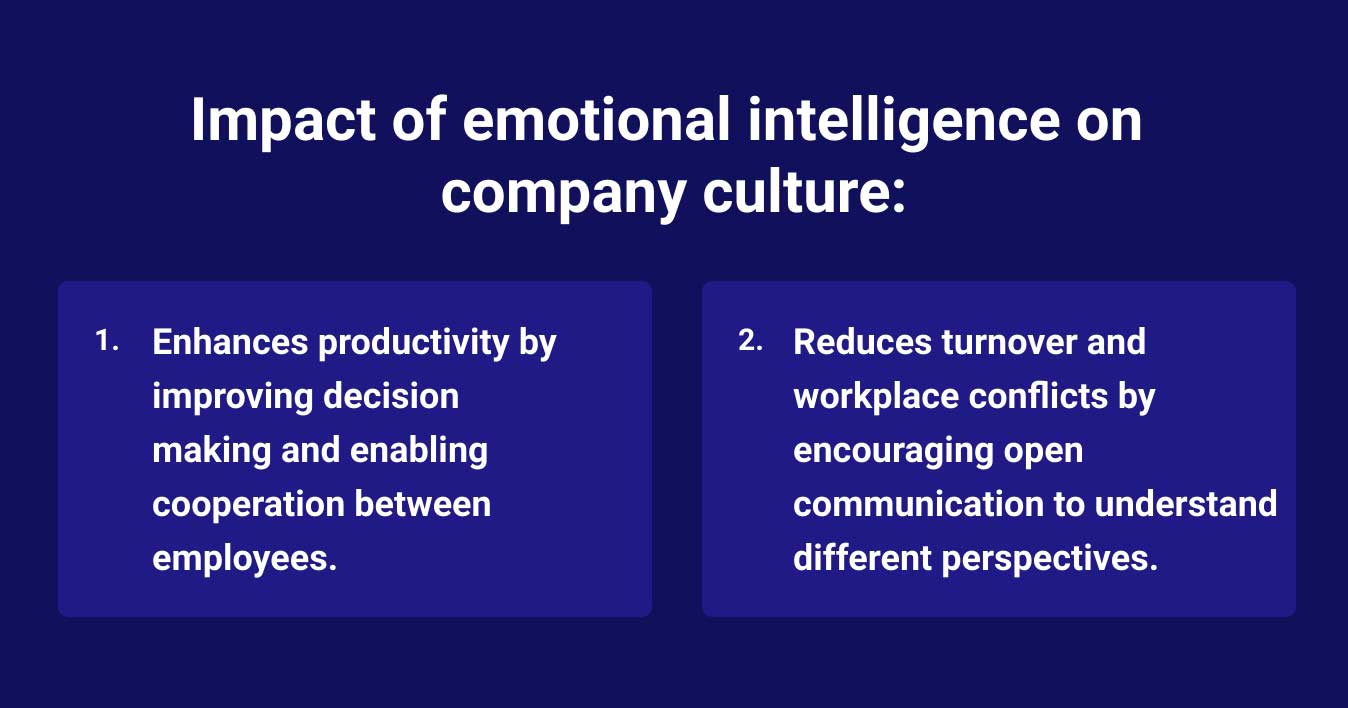
16 emotional intelligence activities to improve your EQ
Let’s talk through a variety of emotional intelligence exercises aimed at boosting social awareness, their own self awareness, enhancing empathy, improving communication, and managing stress among team members.
1. Self-assessment tools
- Emotional intelligence worksheets: Start with worksheets that ask you to reflect on your responses, triggers, and strategies for regulating emotions. You can find free EQ worksheets and workbooksOpens in a new tab online that guide you through these concepts.
- Self-assessment worksheets: Use a self-assessment worksheet to gauge your current EQ levels and pinpoint areas that could use improvement.
If you want your team to develop emotional intelligence, you need to equip them with the tools to do so. Self-assessment tools and tests serve as the cornerstone for understanding and developing emotional intelligence in the workplace as they help build social awareness.
Emotional intelligence assessment tools provide individuals with the opportunity to reflect on their emotional competencies, identifying specific areas where they excel and uncovering aspects that require further development.
These tools provide a structured method for measuring emotional intelligence, facilitating targeted personal growth, and improving interpersonal dynamics.
2. Emotional awareness exercises
- Daily emotion journaling: Encourage employees to journal daily about emotional experiences and reactions, boosting self-awareness. The focus should be on capturing immediate emotional responses.
- Reflection diaries: Encourage employees to keep reflection diaries where they can note their daily experiences, feelings, and lessons learned, fostering personal growth and development.
- Group reflective sessions: Hold regular group sessions where employees can share insights from their journaling, fostering a culture of openness and mutual support.
Emotional awareness activities, such as journaling and group discussions, are pivotal in cultivating an environment where employees can explore and understand their emotions and the emotions of their colleagues.
Journaling helps individuals understand their emotional patterns and triggers, while group discussions provide a platform for sharing experiences and perspectives, enhancing mutual understanding and respect within the team.
3. Empathy building activities
Empathy-building activities, such as role-playing and scenario analysis, are designed to put employees in others' shoes, fostering a deeper understanding of diverse perspectives and emotional experiences.
Role-playing scenarios that mimic real-life workplace situations enable team members to explore and empathize with different viewpoints, enhancing their ability to connect with and support each other in a more meaningful way.
4. Communication workshops
- Active listening exercises: Pair employees to share a story while the other practices listening without interrupting, then repeat the key points back.
- Non-verbal communication practice: Activities that focus on reading and expressing emotions through body language, like mirroring exercises or interpreting emotions from facial expressions without verbal cues.
- Role-playing scenarios: Act out different workplace scenarios to practice and observe emotional responses, interpersonal dynamics, and effective use of business EnglishOpens in a new tab in conversations.
Communication workshops focus on refining skills in active listening and expressive communication. By focusing on techniques that improve how we listen and communicate, these workshops empower employees to express themselves more clearly and empathetically, leading to stronger relationships and more collaborative teams.
Additionally, encouraging employees to share stories about how they have gone above and beyond can foster a sense of community and emotional connection. Sharing these stories can help employees see how their work makes a difference to others in their organization, customers, or society.
Building a more human workplace is about more than just engaging employees—it’s about promoting people’s strengths, capabilities, and functions.
Download the report and learn :
- Strategies to build a more human work culture
- How to support well-being when resources are limited
- Quick tips for recognizing great achievements from your people
5. Stress management techniques
- Mindfulness and meditation: Start with 5-10 minutes of daily meditation. Encouraging employees to practice mindfulness and meditation can significantly reduce stress levels. These practices help individuals remain present in the moment, reducing anxiety and improving focus and clarity.
- Yoga and physical activities: Offering free yoga classes or encouraging movement during breaks can help alleviate physical stress and improve physical health and mental health. Physical activity releases endorphins, enhancing mood and energy levels.
- Breathing exercises: Teach simple breathing techniques or offer free access to a mediation app that employees can use during their workday to provide immediate stress relief and promote relaxation.
- Nature walks and outdoor breaks: Encouraging short walks outside or creating a green space where employees can relax can significantly impact stress levels. Nature has a calming effect, helping to refresh and reset the mind.
Stress management techniques are vital tools that help you navigate the pressures of daily life, especially within the workplace. By adopting strategies such as mindfulness meditation, deep breathing exercises, and regular physical activity, employees can significantly lower their stress levels and improve their overall emotional balance.
This form of self management encourages employees to focus on the present moment, reduce tension, and foster a sense of calm. Additionally, engaging in activities like yoga or creative hobbies can offer an outlet for stress, promoting relaxation and well-being.
By integrating these stress management techniques into your routine, you not only enhance your personal health but also contribute to a more positive and productive work environment.
6. Feedback and check-in sessions
- 360-degree feedback: Implement a 360-degree feedback system where employees receive constructive feedback from peers, subordinates, and supervisors, promoting a culture of continuous improvement.
- Weekly check-ins: Regular check-ins provide employees with consistent opportunities to reflect on their experiences, challenges, and motivations. By engaging in open and honest conversations with their managers, employees can gain a deeper understanding of their own emotions, strengths, and areas for development, leading to enhanced self-awareness.
Frequent, high-quality check-ins between managers and employees are essential. Learn 12 helpful tips for managers and employees to have more positive check-in experiences.
- Feedback training workshops: Conduct workshops to teach employees how to give and receive feedback effectively, focusing on positivity, growth, and development.
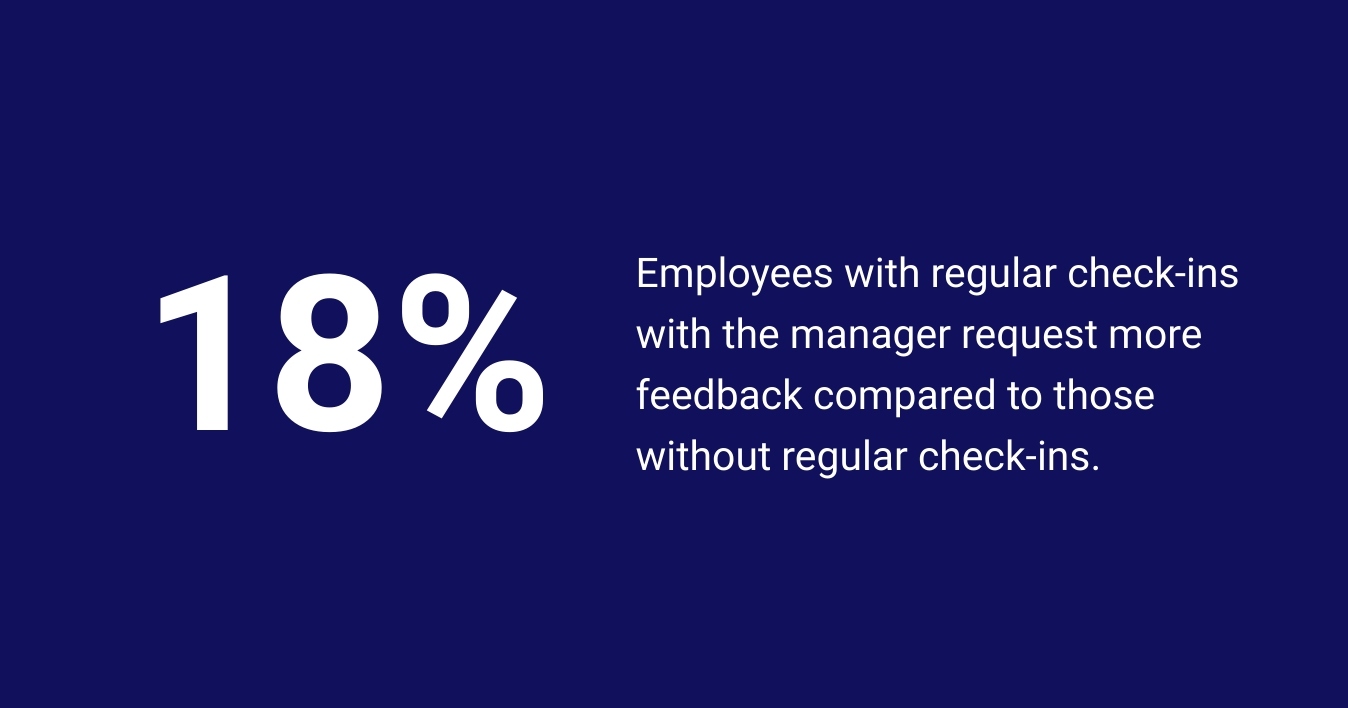
In feedback and check-in sessions allow employees to request and receive targeted feedback from managers, peers, and both formal and informal mentors. These sessions empower your employees to reflect on their experiences, strengths, and areas for growth, fostering a deeper self-awareness.
Research has found that a majority (82% of employees) appreciate both positive and negative critical feedback.
Check-ins are crucial for your employee’s personal development and for cultivating a culture of continuous improvement and teamwork.
7. Visiting/revisiting your values
- Values clarification workshops: Offer workshops that guide employees through the process of identifying and clarifying their personal and professional values. These sessions help individuals align their actions with their core beliefs, enhancing integrity and authenticity in the workplace.
- Values reflection exercises: Provide exercises that encourage employees to regularly reflect on how well their daily behaviors align with their defined values. This ongoing practice promotes consistency and accountability, fostering a values-driven culture within the organization.
Revisiting and reinforcing personal and professional values is crucial for maintaining a sense of purpose and direction in one’s career.
By clearly understanding and regularly reflecting on their values, employees are better equipped to make decisions that resonate with their goals and ethical standards. This alignment not only boosts personal fulfillment and job satisfaction but also strengthens team cohesion and organizational integrity.
Regular engagement with one’s values cultivates a deeply rooted, values-led approach to work, driving meaningful actions and interactions within the workplace.
8. Gratitude exercises
- Daily gratitude sharing: At the beginning of team meetings, allow each member a moment to share one thing they're grateful for, either personally or professionally.
- Gratitude wall: Create a physical or virtual "wall", like Workhuman’s® Social Recognition platform, where employees can post notes of gratitude towards colleagues, projects, or personal achievements, visible to the whole team.
Sharing recognition and gratitude among colleagues can foster a culture of appreciation and emotional connection.
Find out how strategic recognition can save your organization more than $90 million in gained employee productivity. Download the Gallup-Workhuman report to see 3 ways recognition improves business outcomes.
Peer-to-peer employee recognition connects people to a shared purpose through a consistent stream of gratitude and acknowledgment, leading to happier employees. We found that 'happier employees help their colleagues 33% more often, spend 46% more time on their tasks, and report being 65% more energized by their work.'
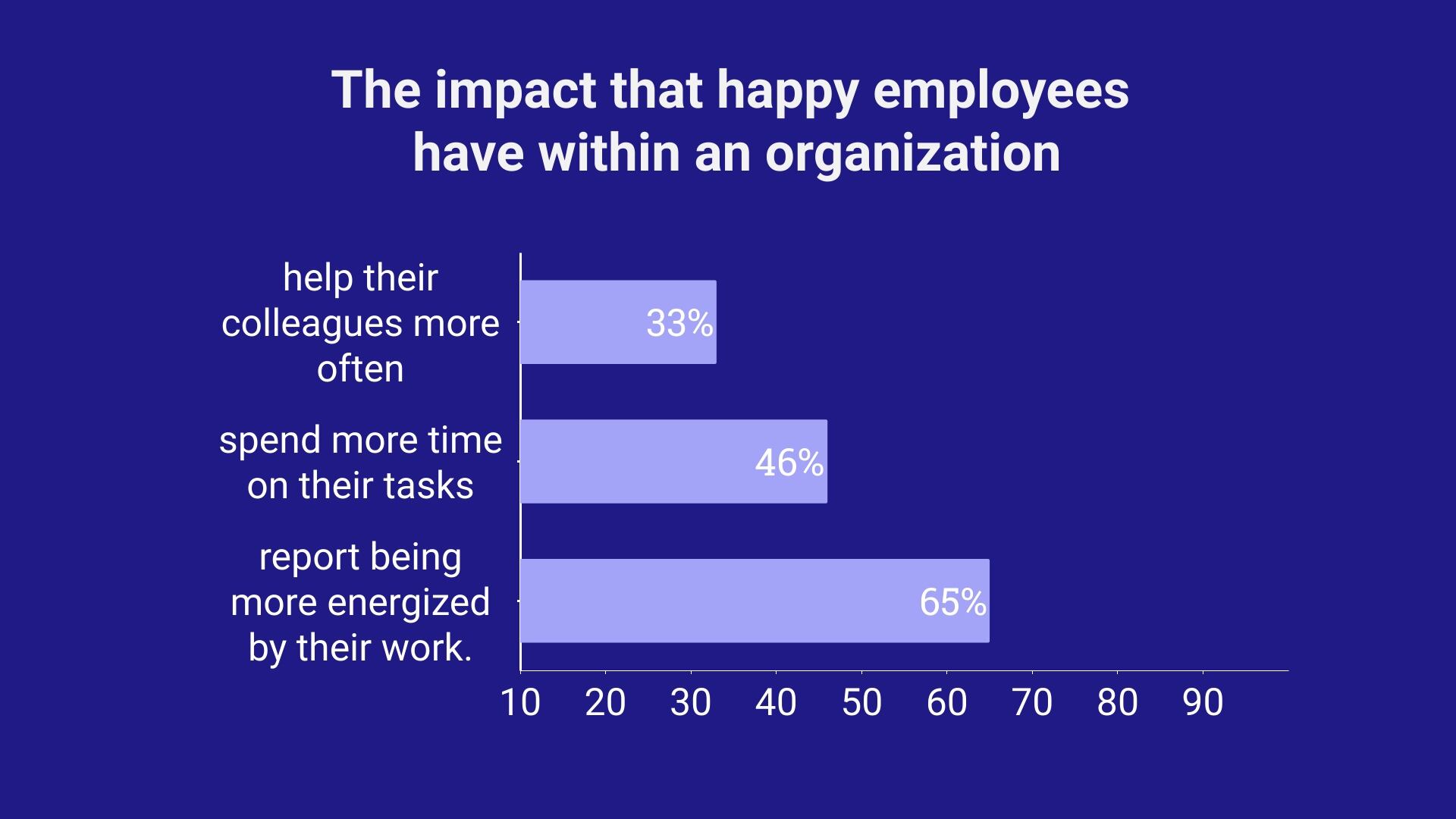
Wondering how do you create a happier workplace? Here are four ways to create a happier workplace and motivated, engaged employees.
9. Conflict resolution role-play
- Scenario-based role plays: Develop scenarios that reflect common workplace conflicts and guide employees through the process of resolution, emphasizing empathy and active listening.
- De-escalation techniques workshop: Focus on teaching employees how to calm tense situations and navigate towards constructive outcomes, using role-play to practice these skills.
Conflict resolution role-play activities create a controlled, safe environment where employees can engage in simulated disputes and challenges. These exercises are vital for developing conflict management skills, enhancing empathy, refining communication abilities, and promoting a supportive team atmosphere.
By practicing in a risk-free setting, employees can build confidence in their ability to handle real-life conflicts effectively.
10. Emotional literacy workshops
- Emotion identification exercises: Use various forms of media or storytelling for employees to identify and discuss the emotions being expressed.
- Emotion labeling: Throughout the day, practice identifying and expressing positive emotions and negative emotions. Name the emotion you’re feeling and acknowledge it. This builds an emotional vocabulary and helps with emotional regulation.
- Expression and articulation practice: Through interactive sessions, encourage employees to articulate their feelings and practice active listening, enhancing their emotional communication skills.
Emotional literacy workshops are designed to advance employees' competencies in understanding, expressing, and managing basic emotions. By broadening their emotional vocabulary and cultivating a culture of open communication, these workshops play a crucial role in enhancing workplace harmony and individual emotional well-being.
Such initiatives not only improve interpersonal relationships but also contribute to a more emotionally intelligent and responsive work environment.
12. Peer coaching circles
- Structured sharing sessions: Regular meetings where each member discusses a current challenge or success, receiving feedback and insights from the group.
- Group reflective sessions: Organize regular group sessions where employees can choose to share insights from their journaling, fostering a culture of openness and mutual support.
- Skill-exchange workshops: Members teach or share a skill they're proficient in, fostering a sense of value and contribution to the group's growth.
Peer coaching circles are small, employee-led groups designed to offer a supportive space for sharing challenges and successes. This collaborative environment promotes empathy, understanding, and emotional support among participants.
By sharing experiences and offering perspectives, employees can learn from each other and develop stronger interpersonal connections.
13. Resilience training
- Workshops on coping mechanisms: Teach practical strategies for managing stress and bouncing back from difficult situations.
- Positive psychology sessions: Introduce concepts and exercises that focus on strengths, gratitude, and optimism to build a resilient mindset.
Resilience training equips employees with the tools and mindset necessary to effectively navigate and recover from professional and personal challenges. By fostering resilience, employees can maintain their well-being and productivity even in the face of adversity.
14. Creative expression sessions
- Art therapy workshops: Provide materials and guidance for employees to create artwork as a form of emotional expression and processing.
- Music and writing groups: Organize sessions where employees can share their musical talents or write together, fostering a sense of community and shared experience.
Creative expression sessions offer a unique avenue for employees to explore their emotions and reduce stress in a supportive and open environment.
Through art, music, writing, or other creative outlets, employees can uncover new ways to express themselves and find relief from the pressures of work.
15. Building confidence through emotional exercises
- Self-affirmations: Begin with daily affirmations that promote a positive self-image and boost self-esteem. Affirmations can reinforce your strengths and help mitigate self-doubt, providing a solid foundation for increased self-assurance in both personal and professional settings.
- Role-playing scenarios: Engage in role-playing exercises that simulate social and professional interactions. These scenarios allow you to practice and refine your communication skills in a low-stress environment, building your confidence in handling real-life conversations and presentations.
Enhancing confidence is intrinsically linked to improving your emotional intelligence through targeted exercises. These activities are designed to fortify your self-perception and bolster your ability to interact effectively in various scenarios.
By consistently practicing these emotional exercises, you develop a stronger sense of self and a more confident approach to interactions. This not only enhances your personal well-being but also improves your effectiveness in collaborative environments, empowering you to lead with assurance and empathy.
16. Teamwork and group identity exercises
- Strengths mapping: Each member lists their strengths and shares with the group, fostering appreciation for diverse abilities.
- Common goals exercise: As a team, identify and align on shared objectives to promote unity and teamwork.
- Bingo: Emotional intelligence games like Bingo add a little fun into the mix. For this activity, create a bingo game with squares representing different emotional intelligence skills. Group members can mark off squares when they observe these behaviors in one another during the week.
For boosting teamwork and strengthening group cohesion, engaging in emotional intelligence training that cultivates mutual respect and shared objectives is key.
Participating in exercises that uncover individual strengths and vulnerabilities creates an understanding of team dynamics, leading to a stronger collective identity and boosting your team’s emotional intelligence and social awareness.
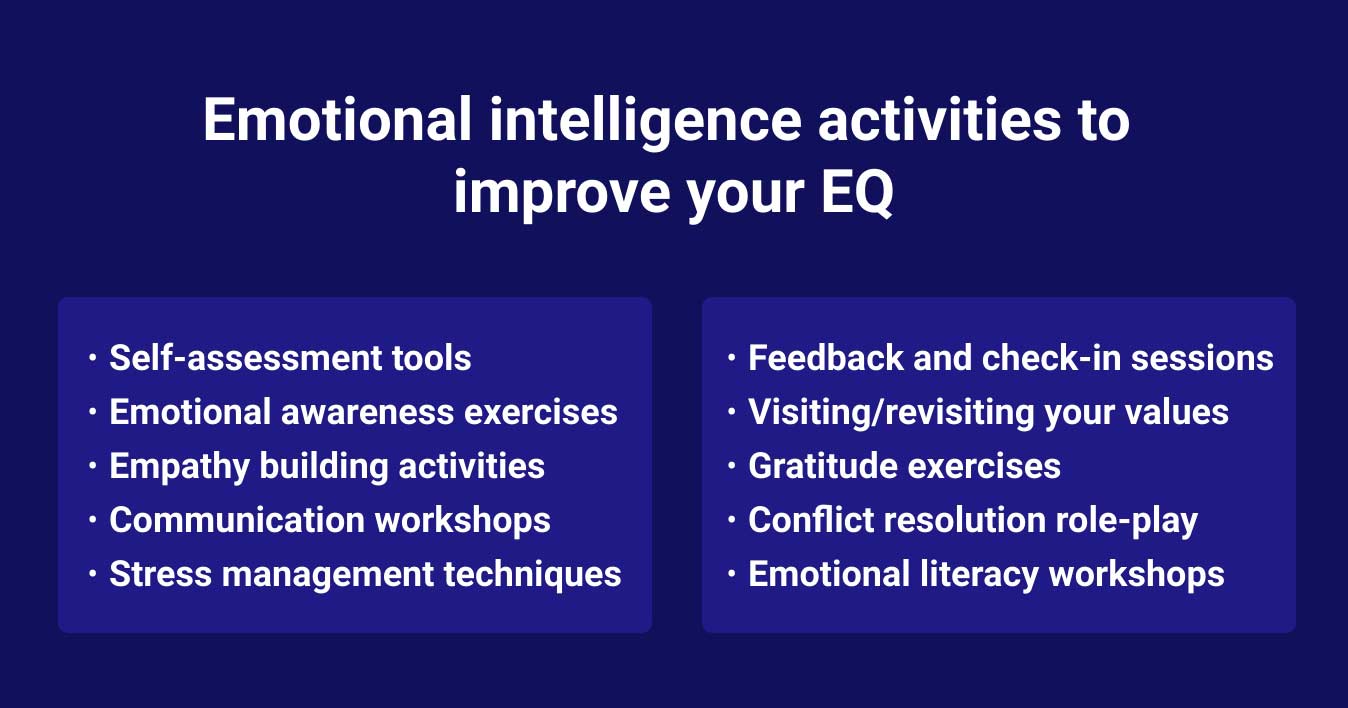
Conclusion
By encouraging self-awareness, empathy, and effective communication, you foster an environment where collaboration flourishes and conflicts are managed constructively. Emotional intelligence activities empower employees to navigate the complexities of interpersonal relationships and leadership challenges with greater ease and confidence.
The ripple effects of a more emotionally intelligent workforce are profound, leading to increased productivity, enhanced employee engagement, and a workplace that adapts resiliently to the demands of an ever-evolving business landscape.
Integrating emotional intelligence activities into your workplace isn't just an investment in individual development – it's a strategic enhancement of your entire organizational culture.
About the author
Ryan Stoltz
Ryan is a search marketing manager and content strategist at Workhuman where he writes on the next evolution of the workplace. Outside of the workplace, he's a diehard 49ers fan, comedy junkie, and has trouble avoiding sweets on a nightly basis.